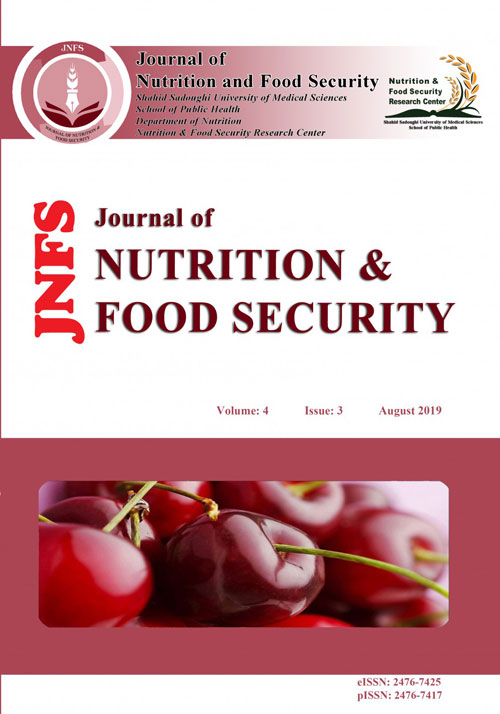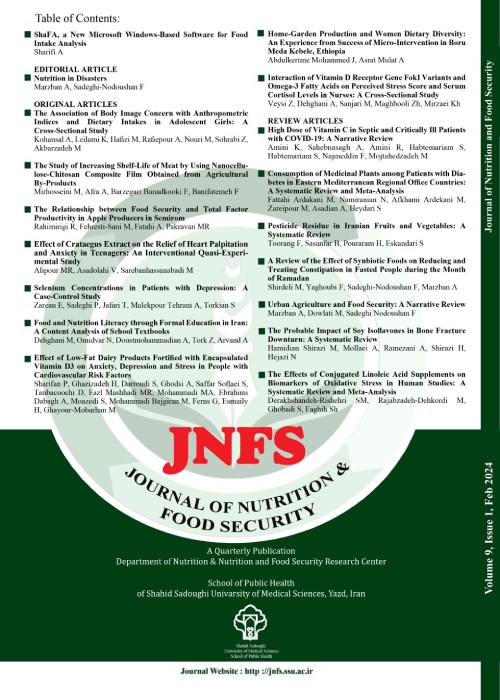فهرست مطالب

Journal of Nutrition and Food Security
Volume:4 Issue: 3, Aug 2019
- تاریخ انتشار: 1398/05/10
- تعداد عناوین: 8
-
Pages 152-160BackgroundFood security status is an important indicator for measuring the level of individuals' access to sufficient and nutritious food. This study was conducted to investigating the food security status in pregnant women in Yazd, Iran.MethodsIn this cross-sectional study, 351 pregnant women with gestational age of 24 to 32 weeks were randomly selected. Food security status was measured by household food insecurity access scale (HAFIS) questionnaire. Demographic information was extracted from the health records of mothers. The data were analyzed using logistic regression test.ResultsThe mean age of studied women was 27.84 ± 5.46 years and the mean of their food security score was 3.45 ± 4.40. Food secure, marginal insecurity, and severe insecurity were observed in 45.6, 39, and 15.4 percent of participants, respectively. Socioeconomic status (SES) and non-Persian ethnicity had a significant relationship (P = 0.40) with food insecurity. Logistic regression analysis showed that the odds ratio of severe food insecurity in the low SES was 13 times higher than its odds in the high SES. The odds ratio of severe food insecurity for non-Persian was also 6 times higher than its odds for Persian people.ConclusionMore than half of the pregnant women were in the mild to severe range of food insecurity and the prevalence of this situation was higher in women with low social economic status and non-native groups.Keywords: Pregnant women, Food security, Yazd
-
Pages 161-169BackgroundConsidering that herbal medicines are commonly used for treatment or management of type 2 diabetes, the aim of this study was to determine the knowledge, attitude, and practice (KAP) of patients with diabetes regarding herbal products.MethodsA cross-sectional study was conducted on 421 patients with diabetes who referred to the Iran Diabetes Association in Tehran, Iran in 2014. The KAP of participants on herbal products were determined by a pre-designed questionnaire containing close ended questions.ResultsThe participnats' age Mean ± SD was 38.0 ± 20.6 years. Of 421 participants, 163 used some type of herbal products during the past year for controlling diabetes. Of these patients, 40 to 60% did not have knowledge about the possibility and desirability of using herbs along with or instead of the anti-diabetic chemical drugs. However, 71% of patients believed that they could not use herbal products without physician's prescription. Participants had a negative attitude towards using herbal products instead of conventional drugs, especially without the physician's prescription (40–60% of patients). Among users of herbal products, 53.0% believed that these products caused no side effects. One-third of patients used herbal products at least once a month for controlling or treating their disease. Most participnats (64.4%) informed their physiciens about consumingherbal drugs and 15.8% had self-prescribed use of these herbal products.ConclusionOur findings indicated that nearly a third of patients with diabetes used herbal remedies and most of them considered these products safe. However, more than half of the patients informed their physician about using herbal medicines.Keywords: Herbal Products, Diabetes, Knowledge, Attitude, Practice
-
Pages 170-175BackgroundSelection of the right foods is the first step to have a healthy society. Food selection criteria depend on the food characteristics and food culture in an area. One of the most important factors in selection of the food items is the individuals' social differences and gender issues.MethodsIn this paper, 500 people were selected from Yazd city. Later, this population was categorized into four categories of 125 and the types of food choices were investigated in each category. The data were analyzed to evaluate the groups using SPSS 16.ResultsThe results showed that the most important factor in selecting a food type was brand, whereas, the least important one was awards and lotteries. The price is the most important criterion for shopping in downtown areas and its rate was higher in men.ConclusionIt can be concluded that the brand, price, and physical and emotional characteristics of food items had greater impact on buyers.Keywords: Consumer, Food choice questionnaire, Food safety, Food consumption
-
Pages 176-185BackgroundMental disorders impose a significant health and economic burden on both developed and developing countries. The relationship between nutrition and mental disorders has become an important topic of interest in recent years. Therefore, identification of modifiable risk factors for anxiety is a serious and critical research imperative. Thus, this study aimed to evaluate the relationship between the “diet quality index international” (DQI-I) and anxiety as a major subject.MethodsThis cross-sectional study was conducted on 194 men and women, who were randomly selected to perform the routine examinations before marriage. In this research, socio-demographic and anthropometric indicators, such a dietary intake1 and mental health were measured. To measure the former, a Food Frequency Questionnaire (FFQ) was applied and to determine the latter, a short version of the self-report depression, anxiety, and stress scale questionnaire (DASS-21) was used.ResultsUnivariate and multivariate linear regressions of anxiety and DQI score demonstrated significant association between DQI score and anxiety in all participants. A negative correlation was also seen between DQI score and anxiety in all participants. The anxiety scores reported for males and females did not introduce a significant difference. Adjustments for age, education, income, job, smoking, physical activity, and body mass index did not change the aforementioned associations.ConclusionIn this study, a significant association was observed between diet quality and the risk of mental disorders. The increase in DQI in participants caused a remarkable reduction in their level of anxiety. A healthy diet proved to be inversely associated with anxiety, while unhealthy dietary patterns were associated with increased risk of anxiety.Keywords: Mental disorders, Anxiety, Nutrient
-
Pages 186-190BackgroundStaphylococcus aureus, Salmonella enterica, Escherichia Coli (E. Coli) and Listeria monocytogenes are considered as important foodborne pathogens. Pistachia atlantica sub sp. Kurdica, called wild pistachio, has been known as an antimicrobial compound. The aim of this study was to determine the antimicrobial activity and chemical composition of this essential oil (EO) on some of foodborne pathogens.MethodsThe EO of Pistachia atlantica was obtained by hydro-distillation and analyzed by GC-MASS. The antibacterial effects of Pistachia atlantica were evaluated at two concentrations of 10 and 15 µL against Staphylococcus aureus, E. Coli, Salmonella enterica, and Listeria monocytogenes using disk diffusion method. The analysis was done by SPSS.ResultsIn the current study, α-pinene (92.5%) and ß-pinene (1.62%) were the main components of Pistachia atlantica EO. The EO was most effective on Salmonella enterica, whereas, its effect on Listeria monocytogenes was the weakest. The results showed a significant difference in reducing Salmonella enterica in comparison to others (P < 0.05).ConclusionThe EO has inhibitory effects on the studied bacteria. Therefore, this EO can be used as a natural preservative to extend the shelf life of foods.Keywords: Pistachia atlantica, antimicrobial, Listeria monocytogenes, Staphylococcus aureus, Escherichia Coli
-
Pages 191-199BackgroundStudies on the relationship of urinary sodium with overweight and obesity led to controversial results. Furthermore, no study has ever investigated the association between sodium status and obesity in Iranian adults. The present study examined the association of urinary sodium levels with overweight and obesity in adults living in Yazd, Iran.MethodsThe present study recruited 240 adults randomly selected from adults, who participated in Yazd Health Study (YaHS). A 24-hour urine sample was collected from the participants. Participants' demographic information, history of chronic diseases, and smoking status were obtained. The height and weight of the participants were also assessed using standard methods. We compared the weight and body mass index (BMI) of the participants based on the urinary sodium excretion tertiles. The logistic regression model in crude and multivariable adjusted models was used to compare the odds of obesity between urinary sodium tertiles.ResultsThe findings showed that the mean urinary sodium was not significantly different among overweight, obese, and individuals with normal BMI (P > 0.05) using the crude and multivariable models. Furthermore, no significant difference was observed in the mean BMI according to urinary sodium excretion tertiles. In addition, the analyses showed that the sodium status was not significantly associated with odds of developing obesity in crude and in multivariable adjusted models.ConclusionNo significant relationship was seen between sodium status and overweight or obesity. Future prospective studies are highly recommended to confirm these results.Keywords: Sodium status, Overweight, Obesity
-
Pages 200-205BackgroundObesity is considered as one of the most important nutrition and health issues among adolescents in the developing countries. In this respect, risks and problems associated with obesity can put a huge burden on the health care system of a society. Moreover, underweight and malnutrition are also prevalent in developing countries and impose enormous health care expenditures on individuals and societies. Thus, this study was conducted to investigate the weight status among 10th-grade high school students residing in the city of Golpayegan, Iran.MethodsA total number of 800 students including 396 boys and 404 girls studying at the 10th grade of high school were included in this cross-sectional research with a descriptive design. The participants were selected using a random cluster sampling method. Moreover, the demographic characteristic information and the anthropometric status (based on the US CDC criteria, 2000) questionnaires were completed for each participant and the data were analyzed using SPSS (Version 16).ResultsThe mean age of the students was 15.6 ± 6.6 years. The total prevalence rate of underweight was 11.4% (91 individuals) including 14.2% in boys and 8.7% in girls. The overweight rate was equal to 10.85% including 10.4% in boys and 11.1% in girls. Furthermore, the rate of obesity was 6.3% including 7.3% and 5.2% in boys and girls, respectively.ConclusionFollowing the specification of the rates of underweight, overweight, and obesity among students, the authorities are recommended to provide proper nutrition programs, good lifestyle, and educational courses for individuals in this domain.Keywords: Obesity, Underweight, Overweight, Body mass index, Students
-
Pages 206-217BackgroundMolybden, as a vital and essential micronutrient is directly involved in the metabolism of other elements including carbon, sulfur, and nitrogen. Molybdenum alone is not biologically active unless it binds to specific cofactors. Except for the bacterial nitrogenase, which contains molybdenum-Iron complex, molybdenum cofactor (Moco) is considered as the bioactive component placed in active site regions of molybdenum-containing enzymes. This review aimed to discuss the biological mechanisms involved in molybdenum metabolism highlighting Molybdenum cofactor deficiencies.MethodsArticles indexed in Pubmed, Google Scholar, and Scopus databases were used to extract the required information.ResultsMoco, as the cofactor of sulfite oxidase, xanthine dehydrogenase, aldehyde oxidase, and nitrite reductase plays a substantial role in maintaining normal body homeostasis and reactive oxygen species (ROS) production. Lack of Moco is found to be associated with many inborn genetic disorders, such as mental retardation, brain immaturity, nervous shocks, and neurodegenerative diseases.ConclusionMoco insufficiency compromises normal human body metabolism since it is reported to regulate the metabolic pathways of other elements. Although in recent years, substitution- and gene-therapies have been introduced to restore the metabolic pathways of patients with MoCD type A and B, the definitive treatment for this type of inborn disease has still remained ill-defined. More investigations are needed to completely understand the underlying pathophysiology of molybdenum-related diseases.Keywords: Molybdenum cofactor, Xanthine dehydrogenase, Sulphite oxidase, Biosynthesis


